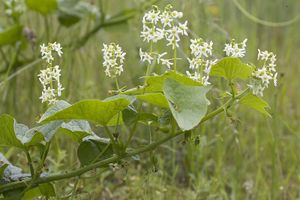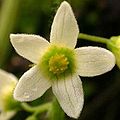Difference between revisions of "Marah oregana"
(→Photo Gallery) |
m (Tag: VisualEditor) |
||
| Line 1: | Line 1: | ||
| − | * Latin Name: ''Marah'' '' | + | * Latin Name: ''Marah'' ''oregana'' |
* Family: Cucurbitaceae | * Family: Cucurbitaceae | ||
* Common Names: coastal manroot | * Common Names: coastal manroot | ||
* Codon: MARORE | * Codon: MARORE | ||
| − | |||
| − | == | + | == Taxonomy == |
| − | + | {{Taxobox | |
| + | | image = MARORE1.jpg | ||
| + | | image_caption = Photo by Rod Gilbert, also featured on Main Page | ||
| + | | name = '''''Marah oreganus''''' | ||
| + | | regnum = [[Plant]]ae | ||
| + | | subregnum = Tracheobionta | ||
| + | | phylum = Spermatophyta | ||
| + | | subphylum= Magnoliophyta | ||
| + | | classis = Magnoliopsida | ||
| + | | subclassis = Rosanae | ||
| + | | ordo = Cucurbitales | ||
| + | | familia = Cucurbitaceae | ||
| + | | genus = '''''Mara''''' Kellogg | ||
| + | | species = ''''' Marah oregana''''' (Torr. ex A. Gray) Howell | ||
| + | }} | ||
| − | + | ==Description== | |
| + | ==Bloom Period== | ||
| − | |||
| − | |||
| − | |||
| − | |||
| − | |||
| − | |||
| − | |||
| − | |||
==Distribution== | ==Distribution== | ||
Majority of California. Streamsides, washes, shrubby and open areas below 1,600 meters (Hickman 1993). | Majority of California. Streamsides, washes, shrubby and open areas below 1,600 meters (Hickman 1993). | ||
==Habitat== | ==Habitat== | ||
| − | ==Uses== | + | ==Uses == |
| − | + | ||
| − | + | ||
| − | + | ||
| − | + | ||
| − | + | ||
| − | + | ||
| − | + | ||
| − | + | ||
| − | + | ||
| − | + | ||
| − | + | ||
| − | + | ||
| − | + | ||
| − | + | ||
| − | + | ||
| − | + | ||
| − | + | ||
| − | + | ||
| − | + | ||
| − | + | ||
| − | + | ||
| − | + | ||
| − | + | ||
| − | + | ||
| − | + | ||
| − | + | ||
| − | + | ||
==Propogation== | ==Propogation== | ||
Clean seed may be rapidly collected from ripening fruits of after falling to the ground from early to late spring. | Clean seed may be rapidly collected from ripening fruits of after falling to the ground from early to late spring. | ||
| Line 113: | Line 92: | ||
==References== | ==References== | ||
| − | |||
| − | |||
| − | |||
| − | |||
| − | |||
| − | |||
| − | |||
| − | |||
| − | |||
| − | |||
| − | |||
| − | |||
==Photo Gallery== | ==Photo Gallery== | ||
<gallery> | <gallery> | ||
Revision as of 21:21, 4 June 2020
- Latin Name: Marah oregana
- Family: Cucurbitaceae
- Common Names: coastal manroot
- Codon: MARORE
Contents
Taxonomy
| Marah oreganus | |
|---|---|

| |
| Photo by Rod Gilbert, also featured on Main Page | |
| Scientific classification | |
| Kingdom: | Plantae |
| Subkingdom: | Tracheobionta |
| Phylum: | Spermatophyta |
| Subphylum: | Magnoliophyta |
| Class: | Magnoliopsida |
| Subclass: | Rosanae |
| Order: | Cucurbitales |
| Family: | Cucurbitaceae |
| Genus: | Mara Kellogg |
| Species: | Marah oregana (Torr. ex A. Gray) Howell |
Description
Bloom Period
Distribution
Majority of California. Streamsides, washes, shrubby and open areas below 1,600 meters (Hickman 1993).
Habitat
Uses
Propogation
Clean seed may be rapidly collected from ripening fruits of after falling to the ground from early to late spring.
Large seeds, weighing 0.5-0.8 grams each, may rapidly be collected from ripening fruits from early-late spring. Pre-Planting Treatments: None, though clean dry seed was placed in dry, cold storage following collection and prior to sowing.
Germination Rate 92% and 85%.
Establishment Phase High germination rates (85-92%) were observed within 3-weeks of planting. Robust seedlings with deep, thick taproots were established by most individuals by the first spring.
Length of Establishment Phase Sprouts were established within approximately 4 weeks.
Active Growth Phase Active growth was observed within 2 weeks after seeding in fall. Plants produced a vigorous clambering vine which died back rapidly and completely by the end of the first spring.
Length of Active Growth Phase Approximately 7 months, from fall through spring, plants senescing by the beginning of summer.
Hardening Phase Hardening is not necessary as the active growth phase starts with the onset of fall rains and plants senesce around the end of spring or beginning of summer.
Harvesting, Storage and Shipping Individuals go dormant following spring-summer dry down and die back to the root. Dormant individuals were placed in dry storage at 60-70 degrees Farenheit.
Length of Storage 2-4 months
Other Look for the mostly 5-lobed white flowers and inflated gourd-like fruits. Compare with grapes (family Vitaceae) which have woody stems and more mumerous minute unshowy flowers. Look for the mostly 5-lobed white flowers and inflated gourd-like fruits. Compare with grapes (family Vitaceae) which have woody stems and more mumerous minute unshowy flowers.
Flowering: Mid January - May (Oswald and Ahart 2002).
Seed collection: March - June/July (seed may be collected on the ground within leaf litter below dried fruits duirng the latter part of the collecting period).
This species has a very high germination rate and rapidly establishes a large, deep taproot with vigorous above ground growth.
Seed
Seed sample from: 2011
Average Measurement: 16.8 x 17 x 8.5
Measurement Range: L: 15 – 18, W: 16 – 18, D: 8 – 9
Features
Shape: Seeds very large, rounded with a pinched looking hilum.
Color: Dark brown, with a lighter brown hilum. Under high magnification seed appears speckled with black.
Surface: Seed covered in very fine velvety hairs. Under high magnification seed appears slightly glossy, but with naked eye, seed is matte.
Latitudinal Cross Section: elliptical ![]()
Longitudinal Cross Section: elliptical ![]()


